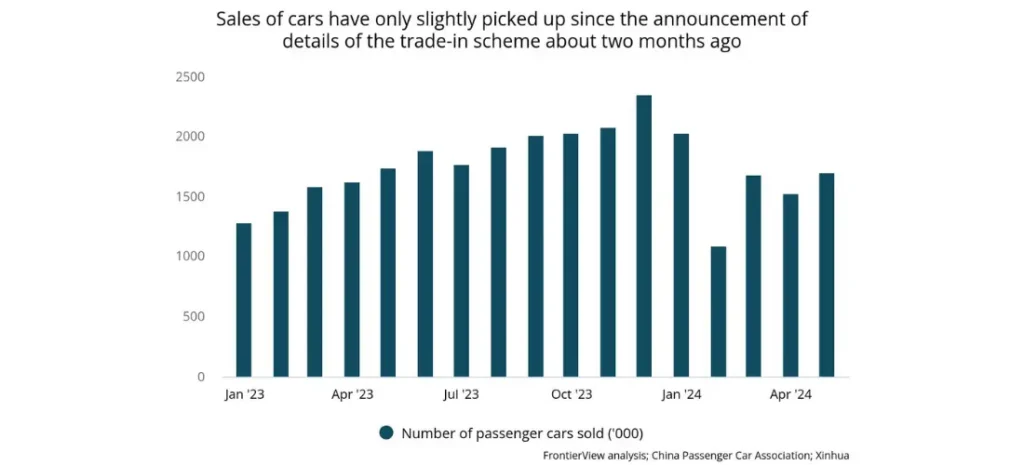
The details of China’s plan to promote trade-ins of automobiles, consumer durables, and industrial equipment have been underwhelming so far
China’s central government has pledged to push for trade-ins (essentially upgrades) in automotive, home appliances, and industrial equipment this year to bolster growth. To kick-start the scheme, the Ministry of Finance has allocated more than CNY 11 billion as subsidies for consumers who trade in their old cars. To qualify for these funds, local governments are required to match the central government’s contributions at specified ratios.
The general direction of the policy has been well received; however, the central government has so far only announced detailed funding support plans for local governments in the automotive trade-in segment. The available data is still too scant to reasonably assess the policy impact on home appliances and industrial equipment. Therefore, this analysis will focus on the automotive sector.
Business Implications
Firms, particularly those in the automotive value chain, should temper their expectations regarding the real impact of China’s trade-in policy and refrain from hastily revising their revenue targets for this year. The additional momentum provided by this policy is unlikely to boost car sales to a level that would significantly alter firms’ pre-set benchmarks.
Simultaneously, firms should focus more on the provinces that have received the most funding from the central government if they aim to capture any upside presented by this policy. However, a thorough cost-benefit analysis is essential to ensure that the strategic pivot brings in sufficient new business without incurring excessive costs.
The government’s policy support appears insufficient to significantly impact consumers’ incentives to trade in their old cars
The central government has specified that the total funds for the automotive trade-in scheme will amount to CNY 11.2 billion this year. Of this amount, the Ministry of Finance will contribute CNY 6.4 billion, while local governments will need to supply the remaining CNY 4.8 billion. The funding match ratios vary by region: Eastern China is required to match funds at a 5:5 ratio, Central China at a 4:6 ratio, and Western China at a 3:7 ratio. The central government has set a trade-in target of 3.78 million cars this year, which represents approximately 17% of total car sales across China over the past 12 months.
According to the plan announced by the central government, Shandong, Guangdong, Zhejiang, Liaoning, and Jiangsu in Eastern China, Hebei and Henan in Central China, and Guangxi and Yunnan in Western China will receive the largest amounts of funding from the Ministry of Finance. However, it is unclear whether many of these local governments, given their strained fiscal positions, will be able to match the required funds.
Take Guangxi as an example: public data shows that the province has so far pledged only CNY 25 million for the automotive trade-in scheme, which falls significantly short of the amount required by the 3:7 ratio. It remains uncertain whether the provincial government will be willing or able to contribute the necessary funds for the program. Any shortfall in funding will likely compromise the province’s ability to achieve its targeted trade-in numbers.
The effectiveness of this policy largely depends not only on whether local governments can match the funds required by the central government, but also on whether the subsidies are substantial enough to incentivize consumers to upgrade. To date, about half of the provinces and municipalities have announced detailed policies to implement the scheme, and some carmakers have also promised to offer their own subsidies. In most provinces, the subsidies for trading in a traditional car are set at CNY 7,000 per car, and for electric vehicles at CNY 10,000 per car. Depending on the car’s price, this represents anywhere between 5% and 10% of the cost of a new car in China today, which doesn’t appear to be a sum significant enough to influence consumers’ decisions to buy a new vehicle. Additionally, many of those consumers who decide to trade in may have already planned to upgrade their vehicles, diminishing the incremental impact of the subsidies.
Official data this week shows that, more than two months after many provinces announced subsidies, only 113,000 applications for trade-in subsidies have been received nationwide. Despite a notable increase in applications in recent weeks, it is quite unlikely that China will achieve the target of 3.78 million trade-ins this year.
At FrontierView, our mission is to help our clients grow and win in their most important markets. We are excited to share that FiscalNote, a leading technology provider of global policy and market intelligence has acquired FrontierView. We will continue to cover issues and topics driving growth in your business, while fully leveraging FiscalNote’s portfolio within the global risk, ESG, and geopolitical advisory product suite.
Subscribe to our weekly newsletter The Lens published by our Global Economics and Scenarios team which highlights high-impact developments and trends for business professionals. For full access to our offerings, start your free trial today and download our complimentary mobile app, available on iOS and Android.

